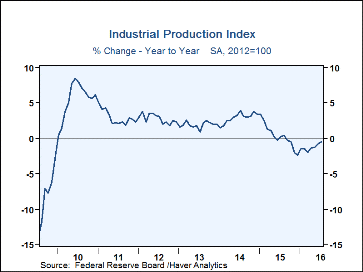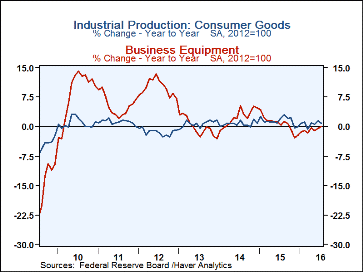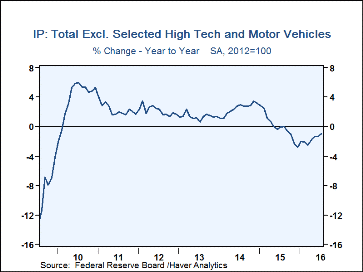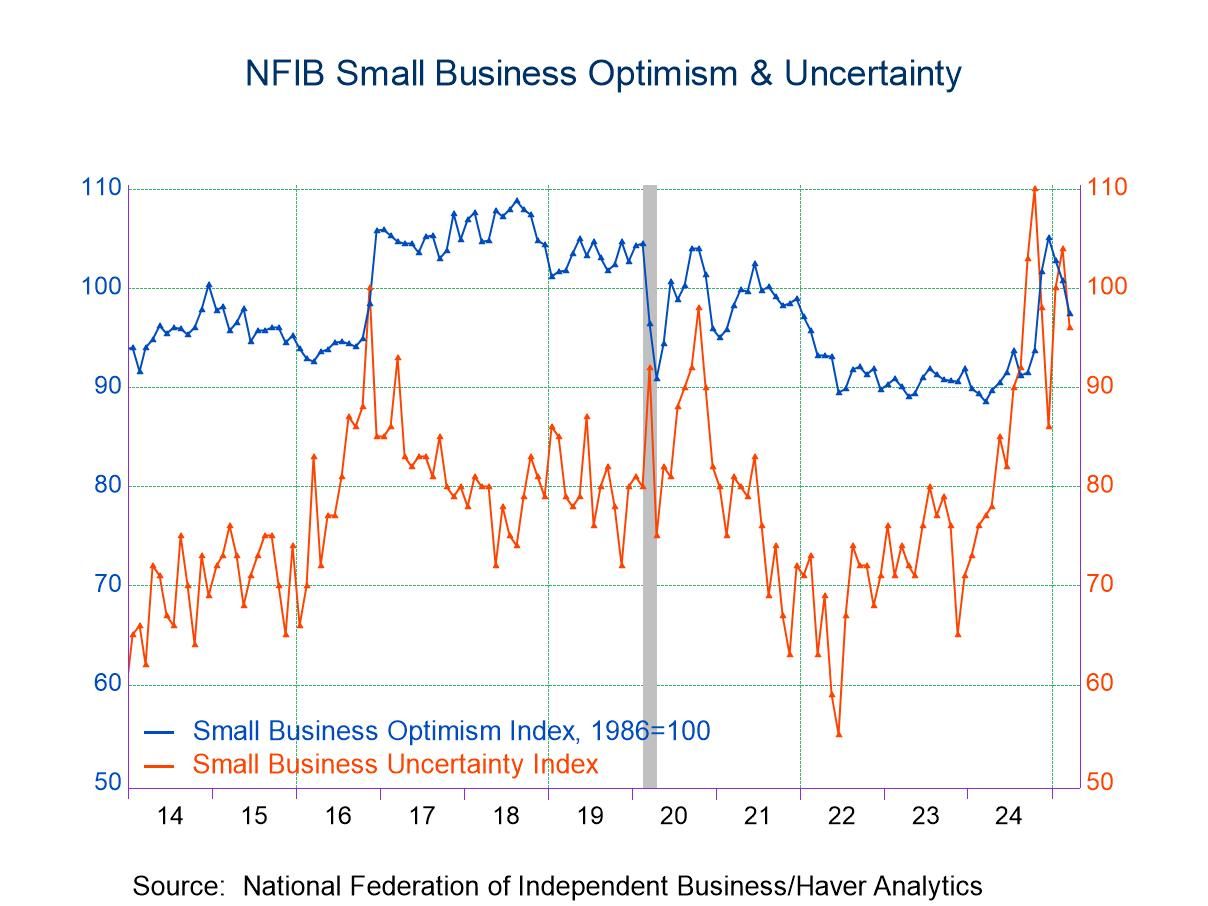 Global| Aug 16 2016
Global| Aug 16 2016U.S. Industrial Production Increase Is Broad-Based
by:Tom Moeller
|in:Economy in Brief
Summary
Industrial output increased 0.7% during July (-0.5% y/y) following a 0.4% June gain, revised from 0.6%. A 0.3% rise in output had been expected in the Action Economics Forecast Survey. Factory sector production rose 0.5% last month [...]
Industrial output increased 0.7% during July (-0.5% y/y) following a 0.4% June gain, revised from 0.6%. A 0.3% rise in output had been expected in the Action Economics Forecast Survey.
Factory sector production rose 0.5% last month (0.2% y/y), its strongest gain since last July. Consumer goods production rose 0.6% (1.6% y/y) as motor vehicle & parts production firmed 1.9% (1.8% y/y). Computer, video & audio production increased 1.3% (1.2% y/y), but appliance production fell 0.5% (+2.4% y/y). In the nondurable goods sector, production increased 0.5% (0.1% y/y) as energy product output jumped 2.2% (3.4% y/y). Chemical output rose 0.3% (-0.3% y/y), but clothing production fell 0.5% (-10.5% y/y). Business equipment production increased 0.6% (0.0% y/y) as industrial equipment production rose 0.7% (0.6% y/y); but information processing equipment output eased 0.1% (+3.6% y/y).
Materials production jumped 1.0% (-1.9% y/y) as energy materials surged 1.7% (-3.1% y/y). Durable goods material output increased 0.8% (-1.1% y/y) and nondurable goods materials production rose 0.7% (0.3% y/y).
Utilities production surged 2.1% (3.5% y/y) while mining output firmed 0.7% (-10.2% y/y).
In the special industrial output groupings, output of high technology products rose 1.0% (5.8% y/y). Computer & office equipment improved 0.2% (2.3% y/y). Industrial production excluding autos & high technology products increased 0.7% (-1.0% y/y).
The overall capacity utilization rate rose to 75.9%, its highest level since December. The factory sector utilization rate rose to 75.4%, the highest level since February. Industrial capacity increased 0.5% y/y)
Industrial production and capacity data are included in Haver's USECON database, with additional detail in the IP database. The expectations figure is in the AS1REPNA database.
| Industrial Production (SA, % Change) | Jul | Jun | May | Jul Y/Y | 2015 | 2014 | 2013 |
|---|---|---|---|---|---|---|---|
| Total Output | 0.7 | 0.4 | -0.2 | -0.5 | 0.3 | 2.9 | 1.9 |
| Manufacturing | 0.5 | 0.3 | -0.2 | 0.2 | 0.8 | 1.3 | 0.9 |
| Consumer Goods | 0.6 | 0.5 | -0.4 | 1.6 | 1.4 | 0.7 | 0.7 |
| Business Equipment | 0.6 | 0.6 | -0.1 | 0.0 | 0.7 | 2.4 | -0.2 |
| Construction Supplies | 0.4 | -0.3 | -0.8 | 0.0 | 1.5 | 3.7 | 3.0 |
| Materials | 1.0 | 0.5 | 0.0 | -1.9 | 0.5 | 4.7 | 3.3 |
| Utilities | 2.1 | 2.1 | -0.4 | 3.5 | -0.7 | 1.3 | 2.3 |
| Mining | 0.7 | -0.3 | 0.8 | -10.2 | -1.8 | 11.0 | 6.5 |
| Capacity Utilization (%) | 75.9 | 75.4 | 75.1 | 76.7 | 76.7 | 78.2 | 76.9 |
| Manufacturing | 75.4 | 75.0 | 74.8 | 75.8 | 75.5 | 75.4 | 74.5 |
Tom Moeller
AuthorMore in Author Profile »Prior to joining Haver Analytics in 2000, Mr. Moeller worked as the Economist at Chancellor Capital Management from 1985 to 1999. There, he developed comprehensive economic forecasts and interpreted economic data for equity and fixed income portfolio managers. Also at Chancellor, Mr. Moeller worked as an equity analyst and was responsible for researching and rating companies in the economically sensitive automobile and housing industries for investment in Chancellor’s equity portfolio. Prior to joining Chancellor, Mr. Moeller was an Economist at Citibank from 1979 to 1984. He also analyzed pricing behavior in the metals industry for the Council on Wage and Price Stability in Washington, D.C. In 1999, Mr. Moeller received the award for most accurate forecast from the Forecasters' Club of New York. From 1990 to 1992 he was President of the New York Association for Business Economists. Mr. Moeller earned an M.B.A. in Finance from Fordham University, where he graduated in 1987. He holds a Bachelor of Arts in Economics from George Washington University.










